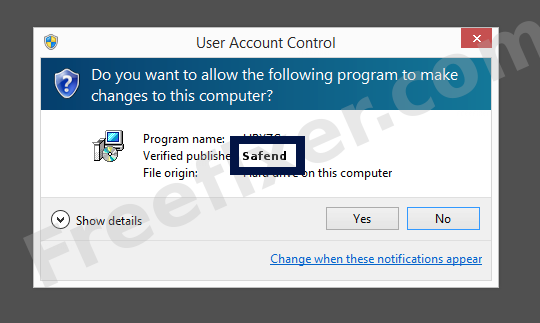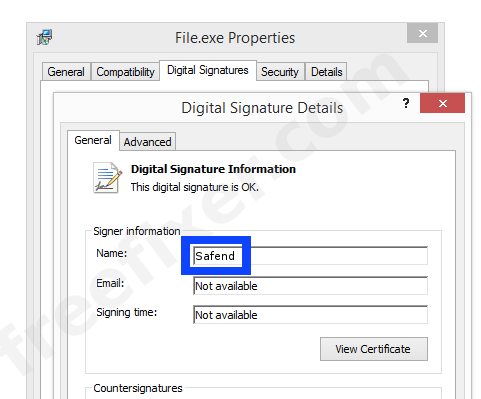Safend - 0.565% Detection Rate *
Did you just download a file that has a digital signature from Safend and wonder if the file is safe? If so, please read on.
You'll typically notice Safend when clicking to run the file. The publisher name is then displayed as the "Verified publisher" in the UAC dialog as the screenshot shows:

You can also view the Safend certificate with the following steps:
- Open up Windows Explorer and locate the Safend file
- Right-click the file and select Properties
- Click the Digital Signatures tab
- Click on the View Certificate button
Here is a screenshot of a file signed by Safend:

As you can see in the screengrab above, the Windows OS reports that "This digital signature is OK". This means that the file has been published by Safend and that the file has not been tampered with.
If you click the View Certificate button shown in the screenshot above, you can examine all the details of the certificate, such as when it was issued, who issued the certificate, how long it is valid, etc. You can also examine the address for Safend, such as the street name, city and country.
VeriSign Class 3 Code Signing 2009-2 CA and Thawte Code Signing CA - G2 has issued the Safend certificates. You can also examine the details of the issuer by clicking the View Certificate button shown in the screenshot above.
Safend Files
The following are the Safend files I have gathered, thanks to the FreeFixer users.
| Detection Ratio | File Name |
|---|---|
| 2/51 | spfd.sys |
| 0/56 | SDPAgent.exe |
| 0/56 | sahara.sys |
| 0/56 | salvador.sys |
| 0/42 | santa.sys |
| 0/42 | Sinadin.dll |
| 0/51 | Sesami.DLL |
Scanner and Detection Names
Here's the detection names for the Safend files. I've grouped the detection names by each scanner engine. Thanks to VirusTotal for the scan results.
| Scanner | Detection Names |
|---|---|
| TrendMicro | PAK_Generic.001 |
| TrendMicro-HouseCall | PAK_Generic.001 |
* How the Detection Percentage is Calculated
The detection percentage is based on that I've gathered 354 scan reports for the Safend files. 2 of these scan reports came up with some sort of detection. You can view the full details of the scan results by examining the files listed above.
Analysis Details
The analysis is done on certificates with the following serial numbers:
- 684af58e506aeb14144b9f70fd1a79c6
- 3a92cfa0cb82dd71e7daf3a0fd8f8a67